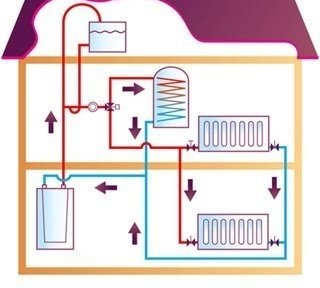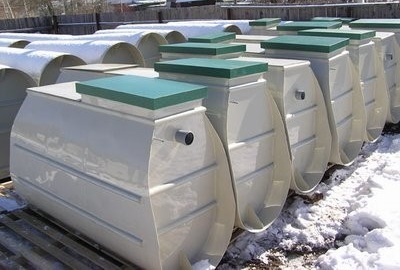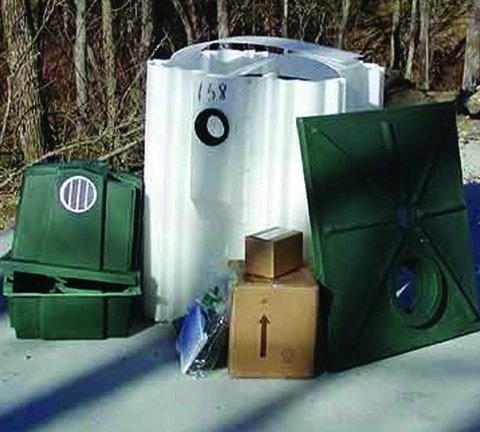Septic Leader: review of strengths and weaknesses + detailed design review
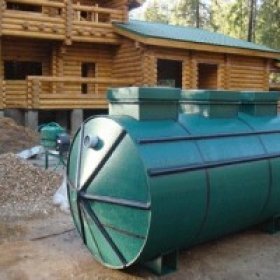
Many consumers, studying the assortment of septic tanks offered by companies, meet identical designs at different prices. It seems that both the principle of operation and the number of compartments are the same, but the price is different. The conclusion suggests itself that individual companies “tear” for brand promotion, although their products have no obvious advantages. It is precisely such disputes that arise on the forums when analyzing the septic tanks of the Leader and Tver companies, since the first one is more expensive, but its technical characteristics are very similar to the models of the second brand. We will figure out how the septic tank leader stands out in a special way, and is it so ideal in work, as suppliers and manufacturers describe.
The main difference between the "Leader" from the installation of "Tver"
The technology for processing wastewater at both septic tanks is identical (it will be discussed a bit later). The main “trump card” of the “Leader”, which influenced the final cost, is a more solid construction of the case. They are made of high-density plastic, or rather, low-pressure polyethylene (HDPE), so it can be mounted in any frost. Tver models become brittle at low temperatures, and if accidentally dropped during installation in winter, they can crack. The same factor also affects the ability of a septic tank to withstand lateral soil pressure.
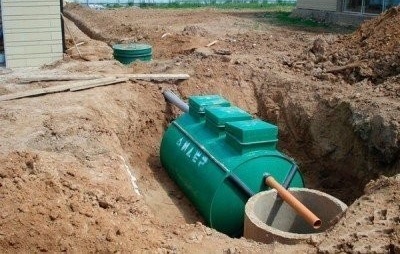
The strength of the body of the Leader septic tank allows it to be installed in the soil without concreting, as the walls can easily withstand soil movements
Septic tank capacity and daily processing volume
The company is developing several models of the Leader, with a compressor power from 40 to 100 watts. The larger the number of inhabitants designed capacity, the more powerful the equipment and higher productivity. So, the smallest septic tank "Leader-0.4" is designed for a family of up to 4 people and is able to process 0.4 cubic meters per day. drains. The most powerful - "Leader-3" can serve up to 30 people. and let 3 cubes of drains through yourself per day.
In addition, models with an additional pump compartment are available. With its help, you can forcibly divert purified water to a specific place. All models with pumping equipment are marked “n” in the name, for example, “Leader-3n”. This option will be approximately 6 thousand rubles. more expensive than its counterpart without a pump.
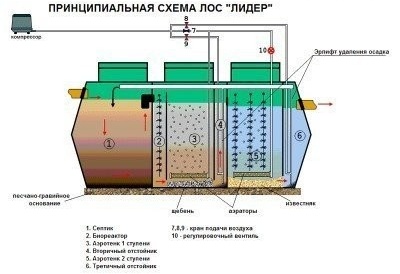
In the Leader septic tanks, a four-stage system for treatment of domestic wastewater has been created, as a result of which all contents are discharged to the outside in the form of purified water and sludge
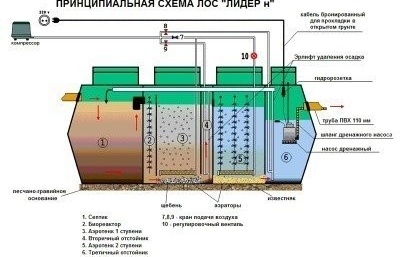
All models of the “Leader” septic tank marked “n” have an additional pump compartment, with the help of which the forced treatment of treated water into the drainage well is carried out
A complete classification of the models is presented in the following table:
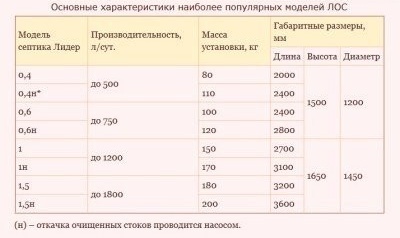
Each model of the “Leader” is designed for a certain number of people, and if an unintended influx of people happens, then the bacteria will not cope with too many drains
Leader Design and Wastewater Treatment Technology
The entire process of wastewater treatment takes place inside one housing, which is divided into several sections. The fluid flows from one compartment to another using airlifts (special tubes).
Section No. 1. Primary sedimentation tank
This is the so-called reception chamber for drains that come from the house through sewer pipes. In it, the contents are fermented and divided into suspended particles and the liquid part. Large organics settle to the bottom, the light floats to the surface in the form of a crust. About ¼ of the entire septic tank is allocated to this camera.
Section No. 2. Bioreactor
The clarified effluents pass into the compartment of the anaerobic bioreactor, where they are "met" by colonies of bacteria that feed on similar contents. They recycle complex organics and decompose it into simple elements. Also in this compartment are suspended particles that managed to slip out of the first compartment.
Section No. 3. First aeration tank
At the bottom of the third compartment there is an aerator (a device in the form of a perforated pipe through which oxygen is pumped into the chamber by a compressor). With its help, the effluents are oxidized, they are further clarified and partially absorbed by bacteria. Colonies of microorganisms live in gravel, which is scattered along the bottom of the compartment.
Section No. 4. Secondary sedimentation tank
This is a small intermediate link with which clarified water flows from the first aeration tank to the second, and the sludge sediment settles to the bottom and is discharged through the airlift back to section No. 1.
Section No. 5. Secondary aeration tank
This is a more powerful aeration tank, because its entire space is filled with colonies of artificial algae-bacteria. They are helped by oxygen coming from the aerator at the bottom of the chamber, and limestone crushed stone. The sewage in this compartment undergoes deep biological treatment, as a result of which phosphate compounds are neutralized, acidity is eliminated, and practically purified water flows into the last chamber.
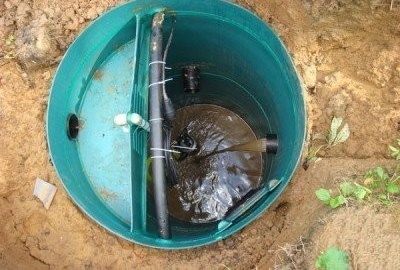
Regardless of the volume of the septic tank, it must be periodically cleaned of solid silt sediments, causing an evacuation machine to be pumped
Section No. 6. Tertiary sump
In the last compartment, the final separation of the sludge takes place, which again returns through the airlift to section No. 1, and the liquid is removed to the outside (by gravity or forced way).
Thus, the entire silty sediment that settles in any of the compartments is discharged into the receiving chamber, from where it will have to be pumped out with a suction machine (1-2 rubles per year). The purified liquid is sent to a sewer ditch or to a specially dug well, where it is filtered and goes into the ground.
The disadvantages of this cleaning system
On the manufacturer’s official website, you can read out information that the Leader septic tank can operate without electricity, and its purified water can be used for gardening needs. Plus - in the septic tank you can dump everything that you sent to a normal sewer: food debris, drains from household appliances (washing machine, dishwasher, etc.).
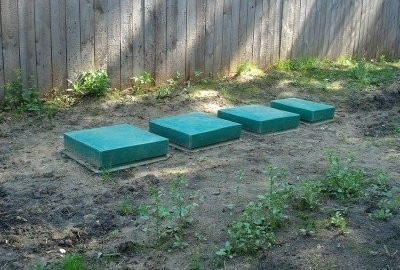
By coloring the case in green, the Leader septic tank can not be decorated, because its covers merge with the lawn grass
But according to people using the Leader system, not everything is so perfect:
- Firstly, in case of power failures that last more than a day, the quality of the wastewater treatment becomes worse, because oxygen does not enter the aerators, which means that bacteria work weaker;
- Secondly, if you do not use the septic tank regularly, but put it in the country house and drive it only occasionally, then the bacteria will not have enough food (it comes with feces), and a fetid smell will gradually appear near the installation site of the system;
- Thirdly, irregular use in the winter leads to freezing of bacteria, and then all the functions of the septic tank go to “no”;
- Fourth, the effluent retains nitrates at the outlet, which means that the use of this liquid in the garden will lead to pollution of the soil and vegetables with harmful substances;
- Fifthly, if salt, alkali and acid are merged into a septic tank (for example, ordinary salt water and vinegar during the preservation of vegetables), this will lead to poisoning and the death of bacteria. The system will recover on its own, but not earlier than after 2 weeks;
- Sixth, an excess of effluents, not calculated on the volume of a septic tank (for example, an influx of guests on a weekend), will lead to a system failure and a fetid odor, which will have to endure for about 2 weeks.
